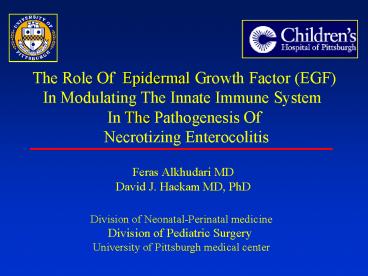The Role Of Epidermal Growth Factor EGF - PowerPoint PPT Presentation
1 / 28
Title: The Role Of Epidermal Growth Factor EGF
1
The Role Of Epidermal Growth Factor (EGF) In
Modulating The Innate Immune System In The
Pathogenesis Of Necrotizing Enterocolitis
Feras Alkhudari MD David J. Hackam MD, PhD
Division of Neonatal-Perinatal medicine Division
of Pediatric Surgery University of Pittsburgh
medical center
2
Necrotizing Enterocolitis
- In NEC, the small bowel becomes injured, develops
edema and intramural air, and may progress to
frank necrosis with perforation. - Most common newborn surgical emergency
- 1-3 cases per 1000 live births
- 1-7 of all NICU admissions in USA
- In VLBW lt 1500 gm, occurs in approximately 10-12
3
The Pathogenesis of NEC
Lumenal bacteria
LPS
Systemic sepsis
Enterocytes
More tissue injury
IL-1
TNF
Activation of WBCs
IL-6
Cytokine release
NEC
4
Toll-Like Receptors Sentinels of the immune
system
Takeda K and Akira S. Int Immun. 2005 17 1-14
Beutler, Science, 1998
5
TLR4 is expressed on enterocytes
SDS-PAGE
Neal et al, J. Immunol 2006
6
Induction of experimental necrotizing
enterocolitis
Newborn mice
Four days
Gavage feed,q 3 hrs
Hypoxia, 2 min BID
NEC
7
TLR4 expression is increased in human NEC
8
TLR4 expression is induced in vitro and in vivo
in response to hypoxia and endotoxin
Endotoxin
Hypoxia
9
Toll-Like Receptor-4 (TLR4)
LPS
LPS
LPS
TLR4
TLR4
MD-2
MD-2
CD14
CD14
MyD88
IRAK4
TLR4
IRAK1
p38
ERK
NF-?B
10
EGF reduces the severity of NEC
- Epidermal Growth Factor (EGF)
- is an endogenous peptide.
- EGF promotes intestinal
- adaptation and is decreased in
- infants with NEC.
- (Warner, et al. JPS 2003, 2000 JBC 2005)
- EGF reduces severity of experimental NEC
- and prevents bacterial colonization and
- translocation in intestinal mucosa.
- (Besner, et al. Sem Ped Surg 2005)
11
Global Study Hypothesis
- EGF attenuates the severity of NEC through
effects on TLR4.
12
Hypothesis I
- EGF reduces LPS-mediated signaling
- in enterocytes.
13
LPS Activates p38 MAPK and ERK in IEC-6
Enterocytes
50 ug/ml
Min after LPS
0 15 60 180 360
phospho-p38
total p38
0 5 15 60 180
Min after LPS
phospho-ERK
total ERK
14
Does EGF Reverse LPS-induced ERK Phosphorylation
in Enterocytes?
EGF 400 ng/ml
LPS (50 µg/ml)
20 min
IEC-6 cells (Rat enterocytes cell line)
Sampling
15
EGF Reversed LPS-Induced ERK Phosphorylation in
IEC-6 Enterocytes
16
Hypothesis II
- EGF attenuates LPS-induced TLR4
- expression in enterocytes.
17
EGF Attenuates LPS-induced TLR4 Expression in
Enterocytes
EGF LPS
Ctrl
LPS
EGF
TLR4
?-actin
18
Hypothesis IIl
- EGF reduces proinflammatory mediators release
(IL6) in enterocytes, in vitro and in vivo.
19
EGF Reduces IL6mRNA Expression in Enterocytes
5
4
3
2
1
0
LPS EGF
Control
LPS
EGF
20
Effect of EGF on IL6 level Expression in the
serum of Endotoxemic Mice
Obtain serum
Detect IL6 level by ELISA
3 hours
LPS 5g/kg or SAL
EGF 10µg/kg Or 20µg/kg
21
EGF Reduces IL6mRNA Expression in Enterocytes
EGF 10µg/kg LPS 5gm/kg
EGF 20µg/kg LPS 5gm/kg
450
450
400
400
350
350
300
300
250
250
200
200
150
150
100
100
50
50
0
0
LPSEGF
LPSEGF
control
EGF
LPS
control
EGF
LPS
22
Hypothesis IV
- EGF reduces IL6 release in enterocytes by
suppressing the translocation of NF-?B .
23
EGF attenuates the translocation of NF-?B
LPS
Control
5
4
3
EGF
LPSEGF
2
1
0
EGF
LPS
LPS EGF
Control
24
NF-?B Activation Assay
- MEF
- C 60 1.119 0.03
- L 60 1.304 0.108
- LE 60 1.189 0.116
- E 60 1.113 0.02
1.4
0
1.3
1.2
1.1
1
0.9
0.8
0.7
0.6
0.5
0.4
0.3
0.2
0.1
0
LPS EGF
Control
LPS
EGF
25
Summary
- Enterocytes express functional TLR4 receptors
- The development of NEC requires the activity of
TLR4 - The TLR4 ligand LPS increases the expression of
TLR4 in vitro and in vivo . - EGF decreases the IL6 release by suppression the
translocation of NF-?B. - EGF attenuates LPS-mediated signaling in
enterocytes, in part through downregulation of
TLR4 expression, suggesting a potential mechanism
for the beneficial effect of EGF in NEC.
26
Role of EGF in attenuating the severity of NEC
through effects on TLR4 signaling and expression
LPS
LPS
LPS
MD-2
CD14
TLR4
MyD88
TLR4
ERK
p38
NEC
X
Inflammation
NF-?B
27
Conclusion
EGF protects the intestine during
endotoxemia through down-regulating
TLR4 expression and reducing LPS-mediated
signaling in enterocytes.
Thus, the regulation of TLR4 signaling
by growth factors suggests potential
therapeutic insights in the management of
intestinal dysfunction during NEC.
28
Acknowledgements
Past and Present Members of the Hackam Lab
Students Anna Evans Kofi Atsina Chris
Rippell Janet Fan Mathew Neal Josh
Dunkleburger Jessica Naiditch Matthew
Rivenbergh Animesh Sabnis
Post Docs Rahul Anand Selma Cetin Cynthia
Leaphart Ward Richardson Xia Hua Shi Chhinder
Sodhi Steve Gribar
Super-techs Jun Li Maria Branca Jeff
Kohler Theresa Dubowski Thomas Prindle
- Funding
- RO1 GM078238-01 to DJH
- Childrens Hospital of Pittsburgh Foundation
- University of Pittsburgh Department of Surgery
- State of Pennsylvania Tobacco Settlement Fund































